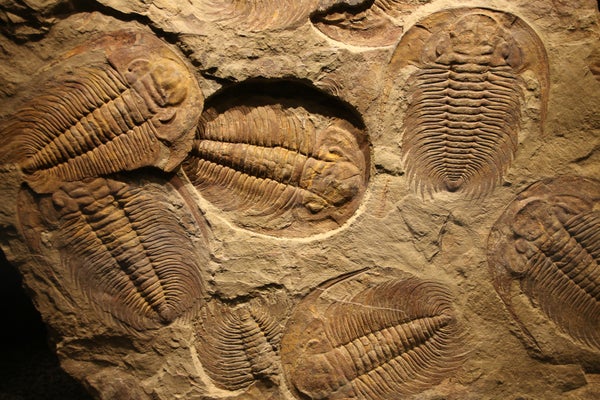Palaeontologists have a fuzzy view of Earth’s history. An incomplete fossil record and imprecise dating techniques make it hard to pinpoint events that happened within geological eras spanning millions of years. Now, a period that saw a boom in animal complexity and one of Earth’s greatest mass extinctions is coming into sharp focus.
Using the world’s fourth most powerful supercomputer, Tianhe II, a team of scientists based mostly in China mined a database of more than 11,000 fossil species that lived from around 540 million to 250 million years ago. The result is a history of life during this period, the early Palaeozoic era, that can pinpoint the rise and fall of species during diversifications and mass extinctions to within about 26,000 years. It is published on 16 January in Science.
“It is kind of amazing,” says Peter Wagner, a palaeontologist and evolutionary biologist at the University of Nebraska–Lincoln, who was not involved in the work. Being able to look at species diversity on this scale is like going from a system where “people who lived in the same century are considered to be contemporaries, to one in which only people who lived during the same 6-month period are deemed to be contemporaries”, he writes in an essay accompanying the study.
On supporting science journalism
If you're enjoying this article, consider supporting our award-winning journalism by subscribing. By purchasing a subscription you are helping to ensure the future of impactful stories about the discoveries and ideas shaping our world today.
Such a view, Wagner adds, will help scientists to identify the causes of mass extinctions—such as the event at the end of the Permian period, some 252 million years ago, that wiped out more than 95% of marine species—as well as understand less dramatic species die-offs and rebounds that have been hard to uncover because of gaps in the fossil record. Understanding these processes could reveal parallels to the planet’s current loss of biodiversity.
Patchy record
Most organisms in Earth’s history didn’t leave fossils, and scientists have identified only a tiny fraction of those that did. As a result, it can be hard to tell whether changes in the fossil record mark real shifts, such as mass extinctions, or are simply caused by a lack of fossil finds.
In the 1960s, palaeontologists began analysing the fossil record systematically, revealing multiple mass extinctions and periods during which life flourished. But these and later efforts could usually pinpoint biodiversity changes only to within about ten million years, because fossils were lumped into relatively long geological periods and analysed en masse.
To improve on this, a team led by palaeontologist Jun-xuan Fan at Nanjing University in China created and analysed a database of fossil marine invertebrate species that were found in more than 3,000 layers of rock, mostly from China but representing geology across the planet during the early Palaeozoic. The group then used software to measure when individual species had emerged and gone extinct.
The program took advantage of the fact that species were usually found in multiple rock formations—each spanning hundreds of thousands to millions of years—and used this information to place upper and lower limits on the period in which the species actually existed. The effort revealed for how long, and in what order, all 11,000 species had existed. It took the supercomputer around seven million processor hours.
Extinctions elucidated
Using this approach, the team was able to learn extra details about well-documented events, such as the end-Permian extinction and the Cambrian explosion in animal diversity around 540 million years ago. The analysis showed, for instance, that species diversity declined in the 80,000 years leading up to the end-Permian mass extinction, which itself occurred over around 60,000 years.
The findings also cast doubt on the existence of a smaller-scale die-off known as the end-Guadalupian extinction, which is thought to have wiped out many marine species around 260 million years ago. That was the biggest surprise, says Mike Benton, a palaeontologist at the University of Bristol, UK, who has documented changes in vertebrate diversity during that period. The study, he adds, “represents a pretty amazing big-data endeavour”.
Benton hopes to see the effort extended to later periods—particularly the past 100 million years. Palaeontologists disagree over whether an apparent increase in animal diversity in this period is the result of sampling bias. “This last 100 million years has been at the heart of a long-running debate about ‘pull of the recent’ and discriminating between real signal and bias,” Benton says.
Norman MacLeod, a palaeontologist at the University of Nanjing and a co-author of the study, says the team’s work might help to reveal the underlying causes of changes in biodiversity, by charting its ups and downs on a timescale that can be matched with environmental and climatic shifts.
Wagner adds that the team’s approach will be most valuable in uncovering—and explaining—smaller-scale extinctions, not dissimilar to those occurring today. Such extinctions could turn out to be “a bad 100,000 years, or a bad week” for some groups of organisms but not others, he says. “When you get this resolution, it starts opening the doors to actually testing what the smaller-turnover events might be like.”
This article is reproduced with permission and was first published on January 16 2020.
